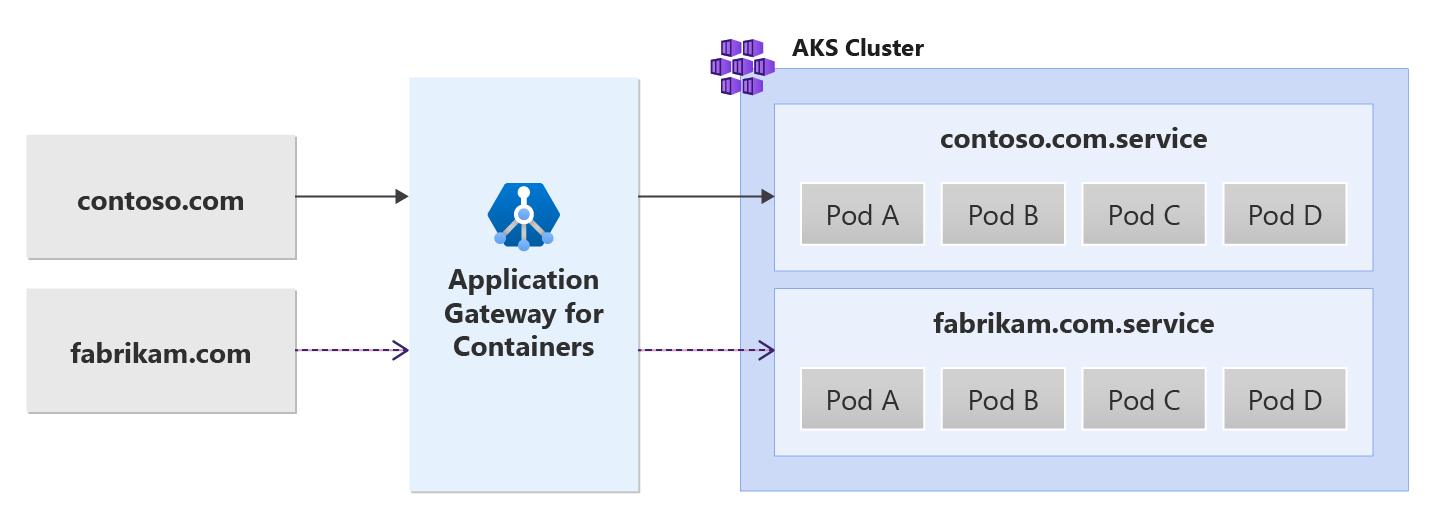你当前正在访问 Microsoft Azure Global Edition 技术文档网站。 如果需要访问由世纪互联运营的 Microsoft Azure 中国技术文档网站,请访问 https://docs.azure.cn。
本文档帮助你设置一个示例应用程序,该应用程序使用网关 API 中的资源来演示如何在同一 Kubernetes 网关资源/用于容器前端的应用程序网关上托管多个站点。 下面是步骤:
背景
容器应用程序网关允许在同一端口上配置多个 Web 应用程序,从而启用多站点托管。 可以使用唯一后端服务托管两个或多个唯一站点。 请参阅以下示例场景:

先决条件
如果使用 BYO 部署策略,请确保为容器资源和 ALB 控制器设置应用程序网关。
如果使用了 ALB 托管部署策略,请确保通过 ApplicationLoadBalancer 自定义资源预配 ALB 控制器和用于容器资源的应用程序网关。
部署示例 HTTP 应用程序:
在群集上应用以下 deployment.yaml 文件来创建示例 Web 应用程序,从而演示基于路径、查询和标头的路由。kubectl apply -f https://raw.githubusercontent.com/MicrosoftDocs/azure-docs/refs/heads/main/articles/application-gateway/for-containers/examples/traffic-split-scenario/deployment.yaml此命令在群集上创建以下内容:
- 名为
test-infra的命名空间 backend-v1命名空间中名为backend-v2和test-infra的两个服务backend-v1命名空间中名为backend-v2和test-infra的两个部署
- 名为
部署所需的网关 API 资源
- 创建网关
kubectl apply -f - <<EOF
apiVersion: gateway.networking.k8s.io/v1
kind: Gateway
metadata:
name: gateway-01
namespace: test-infra
annotations:
alb.networking.azure.io/alb-namespace: alb-test-infra
alb.networking.azure.io/alb-name: alb-test
spec:
gatewayClassName: azure-alb-external
listeners:
- name: http-listener
port: 80
protocol: HTTP
allowedRoutes:
namespaces:
from: Same
EOF
注释
当 ALB 控制器在 Azure 资源管理器中为容器资源创建应用程序网关时,它将对前端资源使用以下命名约定: fe-<eight randomly generated characters>
若要更改在 Azure 中创建的前端资源的名称,请考虑遵循 自带部署策略。
创建网关资源后,请确保状态有效,侦听器已编程,并地址已分配给网关。
kubectl get gateway gateway-01 -n test-infra -o yaml
成功创建了网关时的示例输出。
status:
addresses:
- type: Hostname
value: xxxx.yyyy.alb.azure.com
conditions:
- lastTransitionTime: "2023-06-19T21:04:55Z"
message: Valid Gateway
observedGeneration: 1
reason: Accepted
status: "True"
type: Accepted
- lastTransitionTime: "2023-06-19T21:04:55Z"
message: Application Gateway For Containers resource has been successfully updated.
observedGeneration: 1
reason: Programmed
status: "True"
type: Programmed
listeners:
- attachedRoutes: 0
conditions:
- lastTransitionTime: "2023-06-19T21:04:55Z"
message: ""
observedGeneration: 1
reason: ResolvedRefs
status: "True"
type: ResolvedRefs
- lastTransitionTime: "2023-06-19T21:04:55Z"
message: Listener is accepted
observedGeneration: 1
reason: Accepted
status: "True"
type: Accepted
- lastTransitionTime: "2023-06-19T21:04:55Z"
message: Application Gateway For Containers resource has been successfully updated.
observedGeneration: 1
reason: Programmed
status: "True"
type: Programmed
name: https-listener
supportedKinds:
- group: gateway.networking.k8s.io
kind: HTTPRoute
创建网关后,为 contoso.com 和 fabrikam.com 域名创建两个 HTTPRoute 资源。 每个域将流量转发到不同的后端服务。
kubectl apply -f - <<EOF
apiVersion: gateway.networking.k8s.io/v1
kind: HTTPRoute
metadata:
name: contoso-route
namespace: test-infra
spec:
parentRefs:
- name: gateway-01
hostnames:
- "contoso.com"
rules:
- backendRefs:
- name: backend-v1
port: 8080
---
apiVersion: gateway.networking.k8s.io/v1
kind: HTTPRoute
metadata:
name: fabrikam-route
namespace: test-infra
spec:
parentRefs:
- name: gateway-01
hostnames:
- "fabrikam.com"
rules:
- backendRefs:
- name: backend-v2
port: 8080
EOF
创建 HTTPRoute 资源后,请确保 HTTPRoute 资源都显示为 “已接受” ,并且对容器资源的应用程序网关 进行编程。
kubectl get httproute contoso-route -n test-infra -o yaml
kubectl get httproute fabrikam-route -n test-infra -o yaml
验证是否已为每个 HTTPRoute 成功更新适用于容器的应用程序网关资源状态。
status:
parents:
- conditions:
- lastTransitionTime: "2023-06-19T22:18:23Z"
message: ""
observedGeneration: 1
reason: ResolvedRefs
status: "True"
type: ResolvedRefs
- lastTransitionTime: "2023-06-19T22:18:23Z"
message: Route is Accepted
observedGeneration: 1
reason: Accepted
status: "True"
type: Accepted
- lastTransitionTime: "2023-06-19T22:18:23Z"
message: Application Gateway For Containers resource has been successfully updated.
observedGeneration: 1
reason: Programmed
status: "True"
type: Programmed
controllerName: alb.networking.azure.io/alb-controller
parentRef:
group: gateway.networking.k8s.io
kind: Gateway
name: gateway-01
namespace: test-infra
测试对应用程序的访问
现在,我们已准备好通过分配给前端的 FQDN 将一些流量发送到示例应用程序。 使用以下命令获取 FQDN。
fqdn=$(kubectl get gateway gateway-01 -n test-infra -o jsonpath='{.status.addresses[0].value}')
如果使用 curl 命令指定服务器名称指示器, contoso.com 则前端 FQDN 会从后端-v1 服务返回响应。
fqdnIp=$(dig +short $fqdn)
curl -k --resolve contoso.com:80:$fqdnIp http://contoso.com
通过响应,应会看到:
{
"path": "/",
"host": "contoso.com",
"method": "GET",
"proto": "HTTP/1.1",
"headers": {
"Accept": [
"*/*"
],
"User-Agent": [
"curl/7.81.0"
],
"X-Forwarded-For": [
"xxx.xxx.xxx.xxx"
],
"X-Forwarded-Proto": [
"http"
],
"X-Request-Id": [
"dcd4bcad-ea43-4fb6-948e-a906380dcd6d"
]
},
"namespace": "test-infra",
"ingress": "",
"service": "",
"pod": "backend-v1-5b8fd96959-f59mm"
}
如果使用 curl 命令指定服务器名称指示器, fabrikam.com 则前端 FQDN 会从后端-v1 服务返回响应。
fqdnIp=$(dig +short $fqdn)
curl -k --resolve fabrikam.com:80:$fqdnIp http://fabrikam.com
通过响应,应会看到:
{
"path": "/",
"host": "fabrikam.com",
"method": "GET",
"proto": "HTTP/1.1",
"headers": {
"Accept": [
"*/*"
],
"User-Agent": [
"curl/7.81.0"
],
"X-Forwarded-For": [
"xxx.xxx.xxx.xxx"
],
"X-Forwarded-Proto": [
"http"
],
"X-Request-Id": [
"adae8cc1-8030-4d95-9e05-237dd4e3941b"
]
},
"namespace": "test-infra",
"ingress": "",
"service": "",
"pod": "backend-v2-594bd59865-ppv9w"
}
恭喜,你已安装 ALB 控制器,部署了后端应用程序,并通过应用程序容器网关上的网关 API 通过不同主机名将流量路由到两个不同的后端服务。